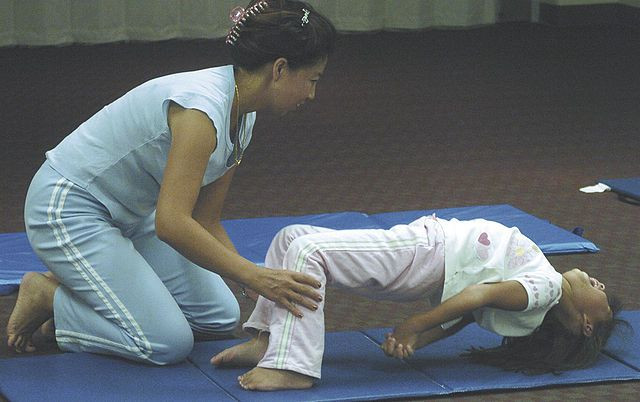Health Benefits Of Yoga: Do Kids Benefit From Yoga In The Same Way As Adults?

Just yesterday, a San Diego Superior Court judge rejected a claim by parents in the Encinitas elementary school system that teaching yoga in the schools is an attempt at religious indoctrination. The suit, filed by attorney Dean Broyles on behalf of a couple with two children in the school system, sought to have the program ousted as a violation of state law prohibiting the teaching of religion in public schools.
Students in the school attend two 30-minute yoga sessions each week. The school district stated that any references to Hinduism and its liturgical language, Sanskrit, have been taken out of its yoga practice. The school program has been supported by a $533,000 grant from a local studio that teaches Ashtanga yoga. This studio is linked to the Jois Foundation, which is supported by hedge-fund billionaire Paul Tudor Jones II and his wife, who were followers of Krishna Pattabhi Jois, a somewhat controversial figure according to The Economist.
Having yoga in the schools "represents a serious breach of the public trust," said Broyles, who is president of the National Center for Law and Policy, to the LA Times. The court's ruling means that the Encinitas Union School District can continue to teach yoga as part of a health and exercise curriculum.
Yoga, the judge decided, is similar to other exercise programs like dodgeball. But is it? And, more importantly, does it benefit children in the same way it has been proven to benefit adults?
Mind-Body Exercise
Among adults, mind-body exercises, including yoga, tai chi, and qigong, have become increasingly popular in the U.S. Many recent investigations by health researchers have suggested the positive benefits of qigong for cardiovascular fitness, musculoskeletal conditions, and stress. Such research, though, is generally limited to adults and the elderly.
The purpose of a recent study was to investigate whether 'mind-body exercise' for the purpose of health is actually effective. Further, how effective is it when compared with conventional exercise among elementary school children?
The design of a recent investigation compared the effects of three different modes of exercise: aerobic exercise, mind-body exercise, and conventional physical education activities. One-hundred-and-five children from two elementary schools in Southern Indiana participated in the study; the average age was nine years old and of the 105 students, 57 (35.2 percent) were boys. Researchers measured the impact of each of these modes on heart rate (HR), sit-and-reach (SR), and body mass index (BMI) during a 16-week intervention with children.
Although all modes showed positive impact on all three measurements among the children, in particular, BMI decreased more quickly among the mind-body exercise group (who practiced a version of qigong) than it did among the children practicing either aerobics or regular PE. According to the Centers for Disease Control and Provention, obesity now affects 17 percent of all children and adolescents in the U.S., which is triple the rate from just one generation ago. The researchers concluded that, given the significant reduction in BMI and the significant problem of obesity in this country, qigong and other mind-body exercises should be further investigated as a possible mechanism to help children lose as well as control their weight.
Would children earn other benefits from a yoga program?
Mental Health
What is yoga's potential efficacy as a tool for establishing well-being and preventing negative psychosocial outcomes among older children? These are the questions posed by Boston researchers associated with Brigham and Women's Hospital and Harvard Medical School, who also evaluated the feasibility of implementing yoga within a high school curriculum. A recent survey indicated that 7.5 percent of adolescents meet the DSM-IV criteria for one or more mental health conditions. Because personal resources, such as mastery, are consistently associated with enhanced resilience, which might prevent onset of a mental health disorder, these researchers had good reason to explore yoga as a potential tool for improving coping strategies and stress management among older children.
Grade 11 and Grade 12 students, all having registered for physical education (PE), were randomly grouped into two classes of yoga or PE-as-usual and so serving as the control group; the ratio, though, favored yoga with twice as many students selected to attend yoga classes. A yoga program of physical postures, breathing exercises, relaxation, and meditation was taught two to three times a week for 10 weeks. Students filled out evaluative questionnaires one week before and after the 10-week session. The psychosocial well-being measurements included tests related to mood, affect, tension/anxiety, and psychological attitudes.
Despite moderate attendance, students rated yoga fairly high. Among the students practicing yoga, total mood disturbance improved while among the students in PE-as-usual, this measurement worsened; the same results held for tension-anxiety. Although positive affect remained unchanged in both groups of students, negative affect significantly worsened among the control group while improving among the yoga students. Overall, the researchers found their results are consistent with previously published studies of yoga in school settings.
This preliminary study, then, suggests that preventive benefits with regard to psychosocial well-being could be found in the practice of yoga during high school. Moreover, the researchers concluded implementation within a high school setting to be feasible as the students generally found it beneficial.
Sources: Wang C, Seo D, Kolbe L. Physical health benefits of health Qigong and Energize programs in American elementary school classrooms. BMC Complementary and Alternative Medicine. 2012.
Noggle JJ, Steiner NJ, Minami T, Khalsa SB. Benefits of yoga for psychosocial well-being in a US high school curriculum: a preliminary randomized controlled trial. Journal of Developmental and Behavioral Pediatrics. 2012.



























